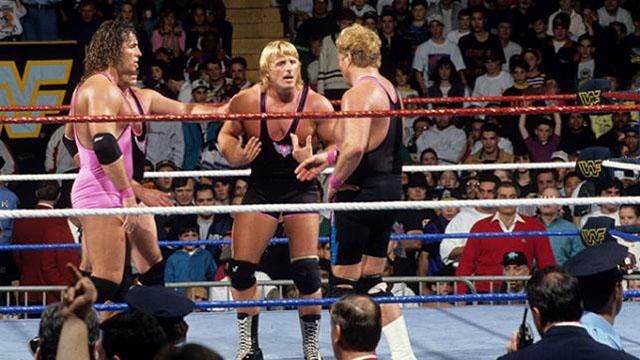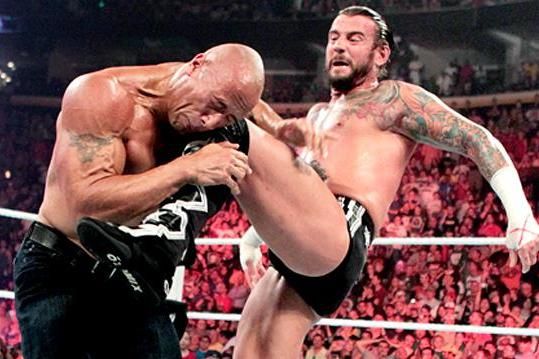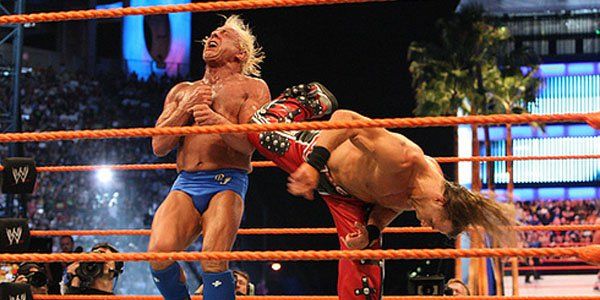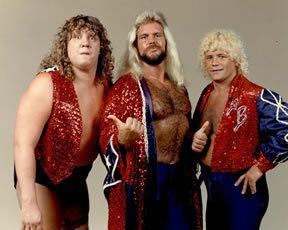wrestling / Columns
The Magnificent Seven: The 7 Most Conflicted Moments in Wrestling
There are plenty of great moments in wrestling history, but some the most underappreciated are the ones in which the booking was complex and thought-provoking enough that fans sincerely did not know how to react. Sometimes that happens in the event of a face or heel turn. Sometimes it’s more complicated than that. This week, I’m counting down seven of the most conflicted moments in wrestling history.

#7. Jimmy Hart Rallies the Troops on Nitro
One of the most fascinating results of the initial NWO invasion of WCW was that it marked a rare occasion when the entire roster of a major US wrestling promotion banded together, blurring face-heel lines to take on an otherwise insurmountable force. One of the signature moments of this transformation was the sight and sound of sniveling heel manager Jimmy Hart—less than a year removed from turning heel to represent the Dungeon of Doom—running to ringside in terror, rallying faces and his own heel rival Horsemen alike to come to the aid of their WCW compatriots who were getting annihilated by The Outsiders in the parking lot.
The moment painted Hart as profoundly human for selling his fear and desperation so well and upped the ante of the fledgling NWO storyline. It created the intrigue of WCW guys claiming they caught a glimpse of a mystery fourth member of the NWO. And, perhaps coolest of all, this innovative bit of television intrigued fans. We all knew the NWO guys were heels, but just the same they were cool and different enough that it was hard not to cheer them.

#6. The Hart Brothers Quarrell at Survivor Series 1993
At Survivor Series 1993, four Hart brothers bound together to take on the heinous Jerry Lawler who had been bashing their family for months. Lawler got pulled due to allegations of sexual misconduct, thus Shawn Michaels took his place (for little kayfabe reason, heading a team of three knights who looked a lot more like cronies for a King than a Boy Toy—but I digress).
The Hart brothers dominated the match, suffering only one elimination before they won. The eliminated party was Owen Hart, who proved irate at what he viewed as Bret’s incompetence for getting in his way, and his other brothers’ favoritism for checking on Bret rather than helping him when he got rolled up for a humiliating pin.
Owen Hart played the jealous little brother gimmick with more conviction and skill than anyone might have predicted from the otherwise vanilla face he had been prior to that point. The aftermath of the Survivor Series match felt less like the beginnings of a heel turn than the legitimate discomfort of watching a family fight in public.

#5. CM Punk Watches The Big Show Take Out John Cena
In July 2012, CM Punk was riding high at the midway point of his historically long WWE Championship reign, when he ran into the unlikely challenge of the other top face in the company John Cena, cashing in his Money in the Bank contract in as honorable a fashion as possible, challenging Punk to a title match one week in advance, for a bout on the 1,000th episode of Raw.
The two had a good enough little match before The Big Show became involved for a schmozz finish, enacting the very first unsuccessful MITB cash-in. From there, Punk looked on in obvious discomfort as Show assaulted Cena. Punk looked like he wanted to help, but was also fully aware that he would only get pummeled for the effort. The choice not to intervene was, therefore, not only a compelling plot note but a perfectly reasonable and realistic choice for a logical human being.
But, of course, the prototypical WWE face can’t stand by while injustice occurs—he has to try to help. Punk didn’t. Moreover, when The Rock did save the day, Punk didn’t make a quiet exit or even try to take credit for The Great One’s handiwork—he nailed him with the Go To Sleep.
This moment was uncomfortable to watch live and, in retrospect, was planned pretty perfectly to shake up the main event scene on a high profile episode of Raw and establish Cena and Rock as Punk’s two key rivals (ok two out of three of his key rivals, with Ryback) for the seven months to follow.

#4. Steve Austin Saves Stephanie McMahon
OK, so in retrospect The Undertaker’s Bride of Frankenstein story in which he aimed to marry/murder/maim Stephanie McMahon was a bit hokey. Just the same, when Steph was a still a new on-air character and portrayed in a squeaky clean light, she was about the most sympathetic victim WWE was likely to find this side of Miss Elizabeth. Moreover, a reinvented, Attitude Era Undertaker was really hitting his stride as the leader of The Ministry of Darkness.
So, when ‘Taker kidnapped Steph and tied her up in the ring, it was darn compelling television. And who better to up those stakes than the one and only Stone Cold Steve Austin who, despite warring with Vince McMahon for over a year at that point just had to do the right thing (as Jim Ross sold brilliantly on commentary) and not let Stephanie suffer on her father’s behalf—especially when Vince himself was edging toward facedom.
Sure, a lot of the implications of this moment would be undone when Vince turned out to be in cahoots with The Dead Man all along, and thinking of Stephanie as a pure, innocent damsel in distress is all but laughable 15 years later. Just the same, this moment itself was electric and occurred at a crossroads when it was unclear just how far The Undertaker’s villainous character would go, how Vince might protect his family moving forward, whether this would prove the wake up call he needed to fully embrace the forces of good, and whether Steve Austin would live to regret helping his long-time arch-rival. It was a conflicted, brilliant piece of wrestling television.

#3. Shawn Michaels Retires Ric Flair
How many times have we seen one man tell another man he loves him, then kick him in the face hard enough to knock him out? Such was the unique, richly conflicted, emotionally charged storyline of Shawn Michaels versus Ric Flair at WrestleMania 24. The two had a phenomenal match to wrap up Flair’s time as an active performer in WWE, and this iconic moment summed up everything this unusual program had ever meant.
Better yet, Michaels retiring Flair paved the way for two more brilliantly conflicted programs, with Batista enraged that Michaels would end the Nature Boy’s, and Chris Jericho towing the lines between concerned friend, investigative journalist, and instigating asshole as he occupied the space between the two stars and began a heel turn.

#2. The Free Birds Start a War with The Von Erichs
If I could pick just one moment in wrestling history to travel back through time to be a part of live, this would be on the shortlist. The scene was Christmas 1982, with Michael Hayes as the guest referee when fellow good guy Kerry von Erich challenged Ric Flair for the NWA World Heavyweight Championship. Hayes and Flair would engage, culminating in Hayes punching out the Nature Boy and trying to get Von Erich to capitalize on his prone opponent. Von Erich was reluctant to win the championship in such morally dubious fashion. A couple miscommunications later, Hayes’s Freebird teammate Terry Gordy was slamming the steel cage door into Von Erich’s head—in that one motion turning the second most popular act in the territory into the most hated three-man unit in WCCW history and launching a feud between the Freebirds and the Von Erich family that would last for years.
Yes, this was a heel turn with nuclear heat, but even more importantly for the purposes of this countdown, it was a moment when fans had to be conflicted. After all, wasn’t Hayes justified in decking Flair? And didn’t they want to see Von Erich win the title? And wasn’t the miscommunication between Von Erich and The Freebirds in the following moment an honest one, and more the fault of Ric Flair than anyone? There were plenty of reasons not to hate The Freebirds that night, but the situation was brilliantly booked to very naturally turn them heel and launch a brilliant storyline and series of matches to follow.

#1. Sting Turns His Back on WCW
It should be little secret to regular readers that I loved the early days of the initial NWO vs. WCW program. Fall Brawl 1996 marked what was, for me, one of the purest pinnacles of the storyline. After getting burned by a series of turns, WCW doubted Sting’s loyalty heading into a War Games match that had The Stinger teamed with Lex Luger, Ric Flair, and Arn Anderson to face off against the best the New World Order had to offer.
A heel Sting doppelganger muddied the waters as the final entrant for the NWO, only for the real Sting to reveal himself as the final entrant in the match, period. Sting proceeded to take out the NWO forces singlehandedly, then snarkily ask his WCW brethren, “Is that good enough?” He did the unthinkable after that, abandoning his teammates in an implicitly heel-ish fashion without actually raising a hand to them, and with the justification that they really had been jerks to him first. After a decade as WCW’s most reliable top tier face, this was the most morally ambiguous thing Sting had ever done—and it was ingenious.
Sting’s walk out cost WCW that match, and set him apart as a mysterious and ambiguous figure in the main event scene who exiled himself to the rafters and didn’t wrestle again for 15 months, setting up a showdown of positively epic proportion between him and Hulk Hogan clashed at Starrcade 1997. Sure, that match was a flop, but the build was sensational, and this moment of sheer conflict was the perfect launching point for one of the best told stories in wrestling history.
What are your favorite conflicted moments in wrestling history? Let us know what you think in the comments section. See you in seven.
Read stories and miscellaneous criticism from Mike Chin at his website and his thoughts on a cappella music at The A Cappella Blog. Follow him on Twitter @miketchin.
More Trending Stories
- Kevin Nash Comments On ‘Antiquated’ Oklahoma State Athletic Commission, Thinks Recent Nyla Rose Ruling Was Political
- Eric Bischoff Thinks Tony Khan Should Bring In Jinder Mahal To AEW
- Booker T On Swerve Strickland’s AEW Title Win, Says Goldberg Wouldn’t Fit There
- The Undertaker on Why Triple H Was Right About Outside Stars Struggling in WWE







